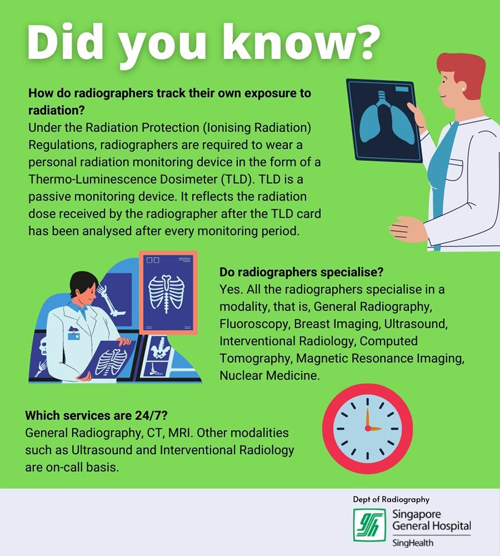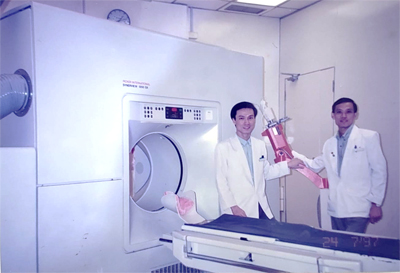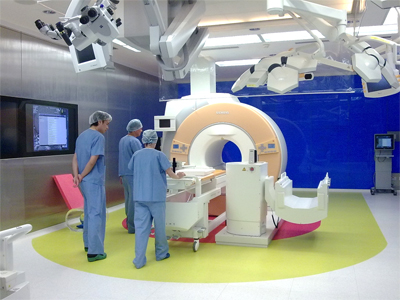By Tay Yi Xiang, Azizah Bte Mohamed Afif
Radiography became a distinct department only last year, in 2020. This brought together both radiography and nuclear medicine imaging. However, radiography in SGH has a long history that began way back in 1913.
“Over the years, our goal is always to reduce radiation doses without compromising image quality. That has guided our decisions to introduce new technology in radiography,” said Aw Lian Ping, Head of Radiography Department.
1. The beginning

X-ray units in the early days where SGH installed their first X-ray apparatus in May 1913.
Under the charge of Dr Middleton, the Municipal Health Officer, an X-ray apparatus was installed in the Municipal office, Singapore, in January 1898 - three years after Wilhelm C. Roentgen’s discovery, and used for two years. At SGH, the first X-ray unit was installed in May 1913. This marked the beginning of medical imaging as an indispensable part of healthcare, for both diagnosis and treatment.
2. Film-screen radiography

(a) Kodak film-screen X-ray Cassette (b) Curved film-screen X-ray Cassettes
The medical X-ray films had to be processed in a dark room. We used Kodak film-screen X-ray Cassette with intensifying fluorescent phosphor screens to capture images of the flexed knee, curved film-screen X-ray Cassettes were used for closed contact x-rays like mandible, or inter-condylar views.

Mr Ng Hon Wing positioning a paediatric patient for a Chest X-ray in the late 1960s in SGH
3. Computed Radiography (CR) and Digital Radiography (DR)
In the 1980s, film-screen radiography transited to the current computed radiography. We started our first computed radiography at Emergency Department in the year 2000. We progressed to digital radiography technology subsequently. These modern techniques allow faster image acquisition and produce higher quality images. DR allows for greater flexibility and efficiency, giving it an edge over CR. The ability to view DR images instantly is key to faster turnaround time, faster diagnosis and better patient outcome. In addition, mobile X-ray units enable bedside imaging of critically-ill patients in intensive care units.

4. Ultrasound

The first Ultrasound imaging unit in Singapore General Hospital
Compared to still radiographic images in the past, today’s medical imaging such as Ultrasound has more dynamic applications. SGH recently initiated an Ultrasound Elastography Liver service, which not only diagnoses the degree of liver fibrosis but also monitors the progression of the cirrhosis thereby helping patients to manage their liver cirrhosis disease.
5. Computed Tomography

The first Computed Tomography Unit in SGH in 1983
Such technological progression is also evident in other imaging modalities like Computed Tomography (CT) . SGH’s present-day inpatient and outpatient CT scanners X-ray beams reduce radiation exposure and examination time while producing high diagnostic quality images for patients.
6. Digital Mammography

Based on the size and texture of the breasts, radiographers will decide whether to use
(a) standard compression paddle or (b) the curved paddle.
Today’s digital mammography equipment reduces radiation dose by 22% as compared to the older screen-film mammography. To reduce discomfort and pain experienced by patients, SGH adopted new approaches such as use of the Curved Compression Paddle.
7. Intraoperative Magnetic Resonance Imaging

Intraoperative Magnetic Resonance Imaging (iMRI)
An Intraoperative Magnetic Resonance Imaging (iMRI) suite was commissioned in 2008. The suite enables MRI real-time images to be taken during surgery, particularly neurosurgery. These images enable the surgeons to carry out intra-operative evaluation to confirm complete removal of brain tumours, which is key to preventing recurrence.
More than just diagnostic
SGH Medical imaging has progressed from purely diagnostic purposes to medical screening, and even treatment such as interventional radiology. As medical imaging professionals, we are excited to be part of the progress in bringing state-of-the-art technology to improve care for our patients.
Special thanks to our long serving staff Ms Koh Bee Hua, Mr Martin Chew, Mr Ng Hon Wing and Mr Lee Wai Sum for their expert advice and encouragement throughout this write-up. We also thank all the Department of Radiography staff who contributed to this article: Aw Lian Ping, Jonathan Mok, Kenneth Yeo, Ong Zhen, Rachelle Tan, Renee Loh, Tan Chin Chong, Yap Bee Ching and Yong Tiong Chong.
We love mail! Drop us a note at lighternotes@sgh.com.sg to tell us what you like or didn’t like about this story, and what you would like to see more of in LighterNotes.
Tags:
;
;
;
;
Internal;
;
Singapore General Hospital;
;
LighterNotes (SGH);
;
;
;
;
Lighternotes
